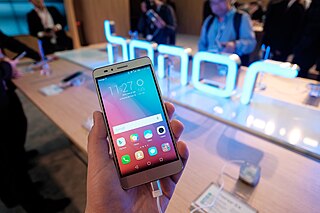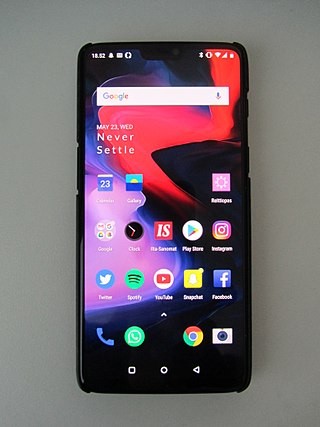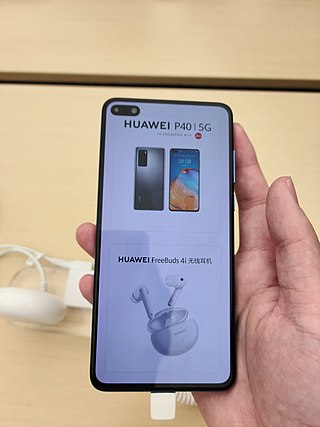Related Research Articles

The Nokia N70 is a 3G mobile phone from Nokia. It was announced as part of the Nokia's new line of multimedia smartphones, the Nseries, on 27 April 2005. It started shipping in September 2005. It runs on the S60 2nd Edition, Feature Pack 3 on Symbian v8.1 operating system. It was succeeded by the Nokia N73. The N70 was popular and sold well.

The Huawei Watch and Huawei Watch 4 are HarmonyOS-based smartwatches developed by Huawei. The Huawei Watch, the first smartwatch produced by the company, was announced at the 2015 Mobile World Congress and released at IFA Berlin on September 2. The Huawei Watch 3 was introduced in June 2021 after the United States Department of Commerce added Huawei to its Entity List in May 2019.

The Huawei Honor 7 is a smartphone made by Huawei under their Honor sub-brand. It is a successor to the Huawei Honor 6, the flagship device under Honor brand for 2014. The models vary for different markets with a gold coloured, dual-sim variant with 64 GB storage capacity being exclusive to China. International model comes with 16 GB storage option and the Indian version hosts only single-sim capabilities.

The Huawei Honor 5X is a mid-range Android smartphone manufactured by Huawei as part of the Huawei Honor X series. It uses the Qualcomm Snapdragon 616 processor and an aluminum body design. It was first released in China in October 2015, and was released in the United States and India in January 2016.

The Huawei P9 is a Chinese high-end Android smartphone produced by Huawei, released in 2016. It is the successor to the Huawei P8 and maintains almost the same design but has a dual camera setup in the back co-engineered with Leica along with a fingerprint sensor. The Huawei P9 has a 5.2-inch Full HD IPS-NEO LCD display and runs on Android 6.0 Marshmallow OS.
The Huawei Mate 9 is a high-end Android smartphone, designed and produced by Huawei as part of the Huawei Mate series. It was released on 3 November 2016. It was succeeded by the Huawei Mate 10 series, and later the Huawei Mate 20 series.

The Huawei P10 is an Android phablet smartphone manufactured by Huawei. Announced at Mobile World Congress 2017 on 26 February 2017, the P10 is the successor to the Huawei P9 and was succeeded by the Huawei P20 in 2018.

The Honor 8 Pro is a smartphone made by Huawei under their Honor sub-brand. It was introduced in April 2017 as a successor to the Huawei Honor 8 within the Huawei Honor series. The phone is known as Honor V9 in China.

The Huawei Mate series, formally the Huawei Ascend Mate series, is a line of high-end HarmonyOS-powered phablet smartphones produced by Huawei, and is one of their flagship products along with the P series.

The Huawei Mate 10, Huawei Mate 10 Pro and Huawei Mate 10 Lite are Android smartphones designed and marketed by Huawei as part of the Huawei Mate series. There is also a Mate 10 Porsche design, which has 256Gb of storage but is otherwise identical to the Mate 10 Pro. They were first released on 16 October 2017. Versus the predecessor Mate 9, the Mate 10 pro flagship phone has a faster processor with an integrated neural processing unit, a slightly larger OLED screen (6.0") with a taller 18:9 aspect ratio, a significantly longer battery life and a glass back construction. Chinese and international models are available in dual SIM configuration. It comes with Android 8 and a newer version of Huawei's EMUI interface. All Mate 10 models are unlocked and GSM only. Huawei phones, including the Mate series, are not sold or financed through U.S. carriers due to pressure from U.S. intelligence agencies, though they are available from independent and online retailers.

EMUI (formerly known as Emotion UI, and also known as MagicOS was a HarmonyOS/Android mobile operating system developed by Chinese technology company Huawei. It was used on the company's smartphones and tablet computers.

The OnePlus 6 is an Android smartphone made by OnePlus. It was unveiled on 2 May 2018 and went on sale on 21-22 May 2018.

The Huawei P series is a line of high-end and medium-range HarmonyOS smartphones produced by Huawei. The P series was formerly marketed as part of Huawei's larger Ascend brand. Some models are called P smart.

Huawei Mate 20 is a line of Android phablets produced by Huawei, which collectively succeed the Mate 10 as part of the Huawei Mate series. The flagship models, the Mate 20 and Mate 20 Pro, were unveiled on 20 July 2018 at a press conference in London.

HarmonyOS (HMOS) is a distributed operating system developed by Huawei for smartphones, tablets, smart TVs, smart watches, personal computers and other smart devices. It has a multikernel design with dual frameworks: the operating system selects suitable kernels from the abstraction layer in the case of devices that use diverse resources. The operating system was officially launched by Huawei in August 2019.

Huawei P40 is a line of high-end Android-based smartphones manufactured by Huawei. Unveiled on 26 March 2020, they succeed the Huawei P30 in the company's P series line.

The Huawei P50 and P50 Pro are HarmonyOS-based high-end smartphones manufactured by Huawei. Unveiled on 21 July 2021, they succeed the Huawei P40 in the P series. In March 2023 Huawei released their successor Huawei P60 Series phones in China, and in May 2023 it released the Huawei P60 Pro in Europe.
The version history of the HarmonyOS distributed operating system began with the public release of the HarmonyOS 1.0 for Honor Vision smart TVs on August 9, 2019. The first commercial version of the IoT based operating system, HarmonyOS 2.0, was released on June 2, 2021 for phones, tablets, smartwatches, smart speakers, routers, and internet of things. Beforehand, DevEco Studio, the HarmonyOS app development IDE, was released in September 2020 together with the HarmonyOS 2.0 Beta. HarmonyOS is developed by Huawei. New major releases are announced at the Huawei Developers Conference (HDC) in the fourth quarter of each year together with the first public beta version of the operating system's next major version. The next major stable version is then released in the third to fourth quarter of the following year.

OpenAtom OpenHarmony, or abbreviated as OpenHarmony (OHOS), is a family of open-source operating systems based on HarmonyOS, donated by Huawei to the OpenAtom Foundation. Similar to HarmonyOS, the open-source distributed operating system is designed with a layered architecture, which consists of four layers from the bottom to the top, i.e., the kernel layer, system service layer, framework layer, and application layer.
References
- 1 2 3 "Honor 10 review: premium phone that punches above its price". the Guardian. 2018-05-29. Retrieved 2021-06-05.
- ↑ "Honor 10 - Full phone specifications". www.gsmarena.com. Retrieved 2021-06-05.
- ↑ "Honor 10 With Dual Rear Cameras, iPhone X-Like Notch Launched". NDTV Gadgets 360. 19 April 2018. Retrieved 2021-06-05.
- ↑ Ngo, Allen (4 July 2018). "Huawei Honor 10 GT smartphone comes with 8 GB of RAM because why not". Notebookcheck. Retrieved 2021-06-05.
- ↑ cnBeta. "荣耀适配HarmonyOS名单出炉:覆盖30多款机型 - Huawei 华为". cnBeta.COM (in Chinese (China)). Retrieved 2021-06-05.
- ↑ Burrell, Henry. "Honor 10 review". Tech Advisor. Retrieved 2021-06-05.